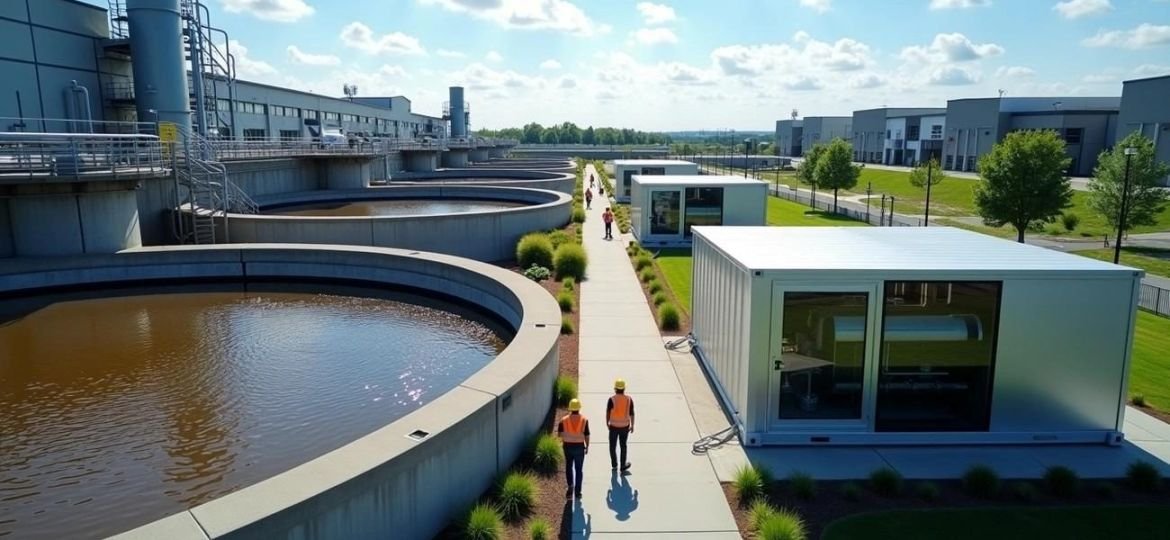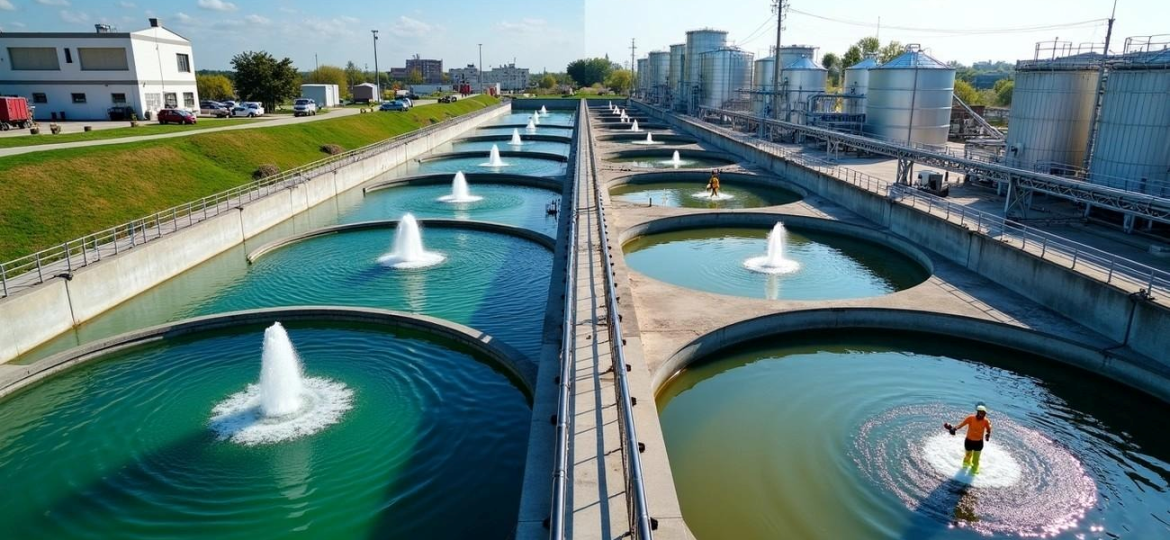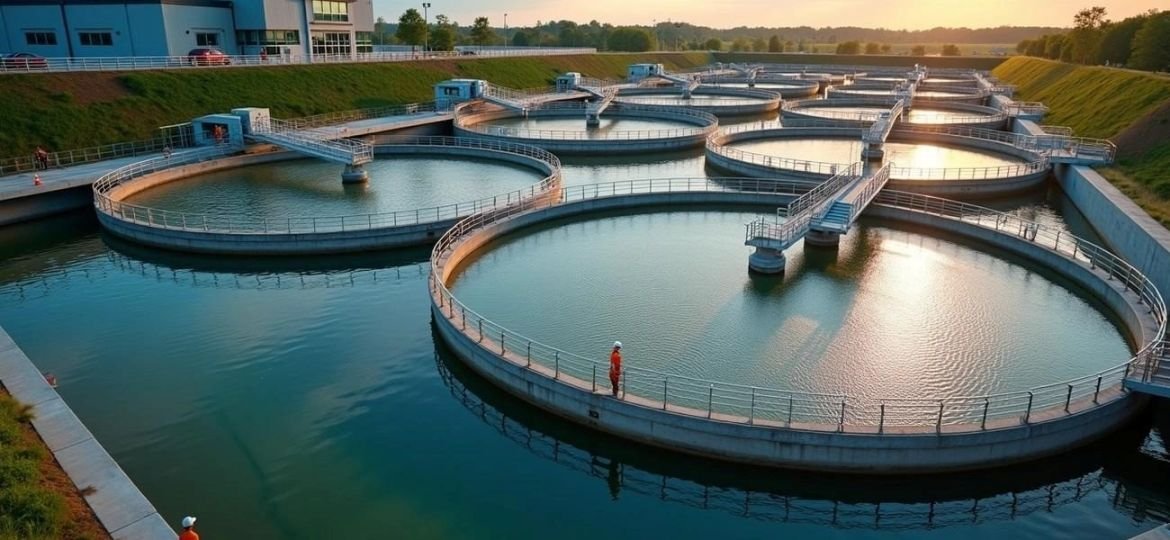Parts Per Million (PPM) is a vital unit of measurement that scientists use to detect trace amounts of contaminants in water, air, and soil. Scientists and engineers rely on this precise measurement to track tiny concentrations that can affect our environment and health.
PPM measurements play a key role in water treatment. They help monitor and control levels of various pollutants and substances in water systems. The PPM calculation in water follows a simple principle – 1 mg/L equals 1 PPM because one liter of water weighs one million milligrams. This measurement helps maintain environmental standards and quality control, especially in sewage treatment processes. High contaminant levels measured in PPM can damage equipment through scaling and corrosion.
This piece will explore PPM’s role in water treatment. You’ll learn how to calculate it, its applications in sewage processing, and the best methods to measure it in treatment plants.
Understanding the Full Form of PPM in Water Treatment

A clear understanding of PPM leads to accurate measurements in water treatment processes. Let’s dive deep into this vital concept.
PPM Full Form in Water and Engineering Contexts
Parts Per Million represents the full form of PPM in engineering and water treatment. This unit measures how concentrated one substance is within another at very diluted levels. One part of a substance mixed with one million parts creates a PPM measurement.
A water sample with 10 PPM of chlorine means you’ll find 10 parts of chlorine in 1,000,000 parts of water. Scientists and engineers like using PPM instead of percentages because it helps them work with tiny amounts that would need complex decimal numbers otherwise.
What is PPM in Water: mg/L and mg/kg Explained
PPM matches up exactly with mg/L (milligrams per liter) in water treatment. This simple match works because a liter of water weighs about one million milligrams. The math shows us that 1 mg/L equals 1 PPM.
Solid materials use mg/kg (milligrams per kilogram) as their PPM measurement, where 1 mg/kg equals 1 PPM. You can turn percentage into PPM by multiplying by 10,000 – making 1% equal to 10,000 PPM.
Water treatment experts use these relationships to figure out chemical dosages and read water quality reports. They often measure TDS (Total Dissolved Solids) in PPM as a key indicator of water quality.
PPM Meaning in Water vs Air vs Solids
PPM measurements change based on what you’re measuring. Fresh water systems follow the 1 mg/L = 1 PPM rule only when water’s specific gravity stays close to 1.
Temperature changes and dissolved ions can shift specific gravity. Seawater’s specific gravity sits at about 1.025. The formula changes to PPM by mass = mg/L / specific gravity when specific gravity moves away from 1.
The mg/L and PPM relationship works great for water solutions but doesn’t always apply to air or other substances. This difference matters a lot when you’re checking pollutants in different environments.
How to Calculate PPM in Sewage Treatment Systems
Accurate PPM calculations are the foundations of sewage treatment operations that work well. Unlike simple measurement, sewage systems need specific calculation approaches to ensure proper chemical dosing and monitoring.
PPM = (Mass of Solute / Mass of Solution) × 1,000,000
The basic formula for calculating PPM in sewage treatment divides the mass of solute (contaminant or chemical) by the total mass of solution, then multiplies by one million. A treatment chemical’s PPM calculation uses 0.2 grams added to 1 kilogram of wastewater:
- PPM = (0.2g ÷ 1kg) × 1,000,000 = 200 PPM
This calculation method works for measuring contaminants like heavy metals and treatment chemicals like chlorine.
Volume-Based Calculation: m³ to ppm
Large sewage operations need volume-based calculations. Density plays a crucial role when working with cubic meters (m³) of wastewater. A sample with 0.0006 m³ of carbon dioxide per 1 m³ of air equals 600 PPM. Wastewater professionals often use this formula:
- Concentration (mg/m³) = 0.0409 × concentration (ppm) × molecular weight
PPM Conversion from Percentage: ×10,000 Rule
Converting percentage concentrations to PPM follows a simple rule – multiply the percentage by 10,000. So:
- 0.1% = 1,000 PPM
- 1% = 10,000 PPM
- 0.01% = 100 PPM
Chemical dosing specifications often list percentages, making this conversion valuable.
Using Online PPM Calculators for Quick Results
Online calculators make PPM calculations easier for sewage treatment plants. They offer four main calculation types:
- Mass by Mass (solid contaminants)
- Mass by Volume (dissolved chemicals)
- Volume by Volume (gaseous components)
- Mole by Mole (chemical reactions)
These calculators help determine chemical dosing rates and treatment costs based on wastewater volume quickly. Some calculators can even estimate total chemical consumption hourly to optimize treatment processes.
Applications of PPM in Sewage and Wastewater Treatment

PPM measurements are the foundations of many critical processes in sewage treatment facilities. These precise measurements help optimize operational efficiency and ensure environmental compliance as we monitor contaminants and adjust chemical treatments.
Monitoring Dissolved Oxygen Levels in Effluent
PPM measurements of dissolved oxygen (DO) play a crucial role in nitrification and denitrification processes. Treatment facilities need to monitor DO concentrations constantly to keep biological activity at its best. DO helps microorganisms convert toxic ammonia to nitrates in nitrification basins. The denitrifying bacteria then turn these nitrates into harmless nitrogen gas. The control of DO levels needs to be exact. Low levels make microorganisms struggle while high levels waste energy through excess aeration. Treatment facilities of all sizes depend on DO monitoring to ensure their operations work well and stay affordable.
Measuring Chemical Dosing in Clarifiers and Aeration Tanks
High Rate Solids Contact Clarifiers (HRSCC) represent how PPM works in chemical dosing. These systems can handle inlet suspended solids up to 3000 ppm. They produce treated water with less than 10 ppm for raw water and under 30 ppm for wastewater. PPM measurements of coagulant and flocculent dosing improve clarification processes substantially. Chemical dosing based on PPM helps optimize water treatment at a lower cost than traditional clarifiers.
Tracking Heavy Metals and Organic Contaminants
PPM measurements help track dangerous contaminants including mercury, cadmium, lead, and chromium. The WHO’s maximum safe limits are specific: 0.0019 ppm for mercury, 0.003 ppm for cadmium, and 0.01 ppm for lead in wastewater. Research shows that heavy metal concentrations are often higher than these limits, which raises serious health concerns. PPM measurements help us find contamination sources and guide cleanup efforts effectively.
PPM in Sludge Dewatering and Filtration Processes
Sludge dewatering operations use PPM measurements to track moisture content and assess how well the dewatering works. Mechanical dewatering can achieve solid content of 20-35% with decanting centrifuges and 28-45% with filter presses. Auto-thermal combustion needs at least 28-33% solid content in theory. The practical minimum for incineration is 40-50%. Different conditioning methods like chemical, thermal, and biological treatments turn bound water into free water. This improves dewatering performance and cuts volume by 60-80%.
Methods for Measuring PPM in Sewage Treatment Plants
Precise measurement methods play a vital role to meet strict regulatory standards in wastewater processing. Scientists employ several techniques that provide accurate PPM detection in sewage treatment facilities of all sizes.
Titration for Chloride and Hardness Detection
Titration delivers reliable PPM measurements for chloride and hardness in wastewater samples. A calibrated dropper releases equal-sized drops of reagent until the solution changes color to mark the endpoint. Scientists calculate results by multiplying the drop count with a conversion factor—each drop typically equals 5 PPM. This technique works best to test acidity, alkalinity, carbon dioxide, hardness, dissolved oxygen, and chlorine levels.
Colorimetry for Phosphate and Nitrate Levels
Colorimetric analysis works on a simple principle: color intensity matches concentration after specific reagents are added. The phosphate detection process uses ammonium molybdate that reacts with orthophosphate in acidic conditions to create molybdophosphoric acid. This acid turns blue once reduced by ascorbic acid. Nitrate tests use the Griess reaction that creates a pink-violet color through diazotization of aromatic amines. Modern portable colorimetric hydrogel test kits can detect levels as low as 0.14 mg/L for phosphate and 0.04 mg/L for nitrate.
Ion-Selective Electrodes for Ammonia and Fluoride
Ion-selective electrodes (ISEs) create electrical signals that match the concentration of specific ions in wastewater. Ammonia ISEs have gas-permeable membranes that allow ammonia to diffuse and alter the internal pH. These electrodes detect ammonia concentrations ranging from 0.02 mg/L to 17,000 mg/L. Accurate results require samples to reach pH 11 through ionic strength adjusters.
Spectrophotometry for Trace Organic Compounds
Spectrophotometry delivers better precision than standard colorimetry by measuring light absorption at specific wavelengths. This method identifies many organic pollutants in sewage through solid-phase extraction and analysis. Wastewater samples flow through C18 cartridges before evaluation. This is a big deal as it means that extraction recovery rates reach 60% for most compounds.
Gravimetric Analysis for Total Dissolved Solids (TDS)
Gravimetric analysis measures TDS by filtering a known volume through a standard glass-fiber filter. The filtrate evaporates at 180°C until it reaches constant weight. This method works with all natural waters and industrial wastewaters. Scientists calculate results in mg/L using this formula: TDS = [(final weight – tared dish weight) × 1,000] ÷ sample volume. Samples that yield less than 2.5 mg or more than 200 mg residue need estimation.
Conclusion
PPM measurements are the life-blood of sewage treatment operations. Parts Per Million works as a universal language to calculate trace substances in water treatment processes. Water treatment professionals use the simple relationship between PPM and mg/L (1 PPM = 1 mg/L in water) as a practical tool in their daily work.
These calculations help make critical decisions in treatment facilities. The simple mass-to-mass ratios and volume-based assessments ensure the right chemical dosing and contaminant monitoring. On top of that, converting between percentages and PPM (1% = 10,000 PPM) helps translate different concentration expressions used by the industry.
PPM measurements are essential in every part of sewage treatment. Clean water depends on precise PPM detection for dissolved oxygen monitoring, chemical dosing in clarifiers, heavy metal tracking, and sludge dewatering. Treatment plants need these measurements to meet regulatory standards and work efficiently.
Each measurement technology – titration, colorimetry, ion-selective electrodes, spectrophotometry, and gravimetric analysis – brings unique benefits to specific applications. Plant operators should pick the right method based on their target substance and needed precision.
PPM measurements may look like just numbers, but they make the difference between clean water and environmental contamination. This simple unit helps treatment plants maintain quality control while optimizing chemical usage and costs. Running a municipal facility or industrial wastewater system? Becoming skilled at PPM principles without doubt creates the foundations of successful sewage treatment.
Key Takeaways
Understanding PPM (Parts Per Million) is essential for effective sewage treatment operations, providing precise measurements that ensure regulatory compliance and operational efficiency.
• PPM equals mg/L in water treatment: 1 PPM = 1 mg/L due to water’s density, making calculations straightforward for dosing and monitoring.
• Simple conversion formula: Calculate PPM using (Mass of Solute ÷ Mass of Solution) × 1,000,000, or convert percentages by multiplying by 10,000.
• Critical monitoring applications: PPM measurements track dissolved oxygen, chemical dosing, heavy metals, and contaminants throughout treatment processes.
• Multiple measurement methods available: Titration, colorimetry, ion-selective electrodes, and spectrophotometry each serve specific detection needs in treatment plants.
• Regulatory compliance depends on PPM: WHO limits for heavy metals like mercury (0.0019 PPM) and lead (0.01 PPM) require precise PPM monitoring.
PPM measurements serve as the universal language of water treatment, enabling operators to maintain water quality standards while optimizing chemical usage and operational costs across municipal and industrial facilities.
FAQs
Q1. What does PPM stand for in water treatment?
PPM stands for Parts Per Million, a unit of measurement used to express the concentration of substances in water. In water treatment, 1 PPM is equivalent to 1 milligram of a substance per liter of water (mg/L).
Q2. How is PPM calculated in sewage treatment systems?
PPM in sewage treatment is calculated using the formula: PPM = (Mass of Solute / Mass of Solution) × 1,000,000. For example, if you add 0.2 grams of a treatment chemical to 1 kilogram of wastewater, the concentration would be 200 PPM.
Q3. What is the significance of PPM measurements in sewage treatment?
PPM measurements are crucial in sewage treatment for monitoring contaminant levels, optimizing chemical dosing, tracking heavy metals, and ensuring regulatory compliance. They help maintain water quality standards while optimizing operational efficiency and costs.
Q4. How do you convert percentage to PPM?
To convert percentage to PPM, multiply the percentage by 10,000. For instance, 1% equals 10,000 PPM, 0.1% equals 1,000 PPM, and 0.01% equals 100 PPM. This conversion is useful when working with chemical dosing specifications often listed in percentages.
Q5. What methods are used to measure PPM in sewage treatment plants?
Several methods are used to measure PPM in sewage treatment plants, including titration for chloride and hardness detection, colorimetry for phosphate and nitrate levels, ion-selective electrodes for ammonia and fluoride, spectrophotometry for trace organic compounds, and gravimetric analysis for total dissolved solids (TDS).






